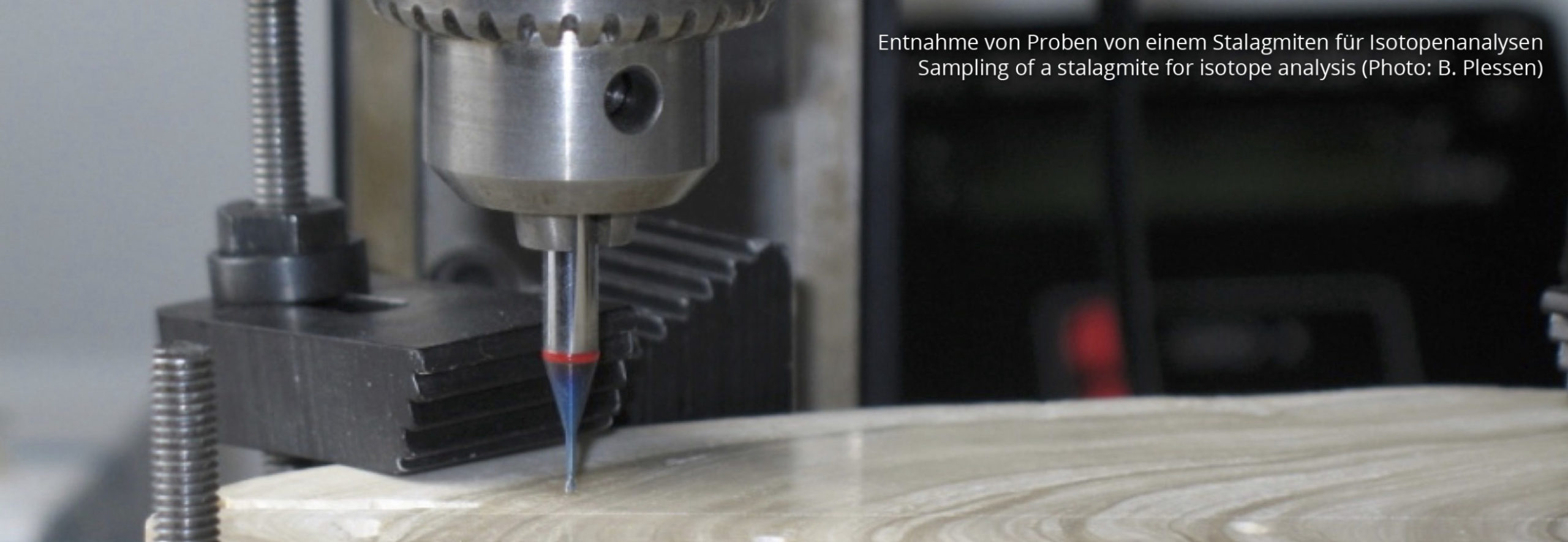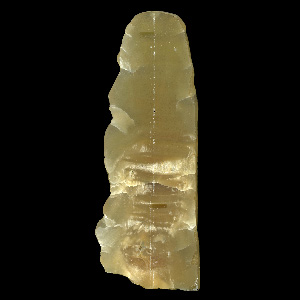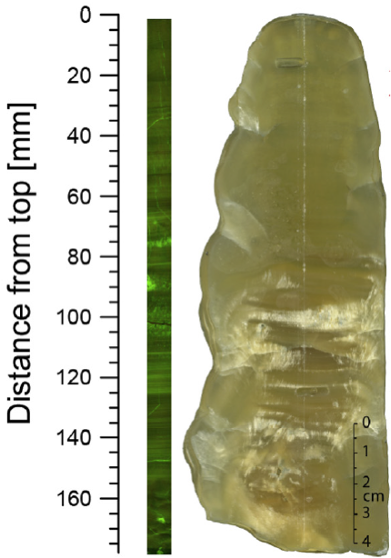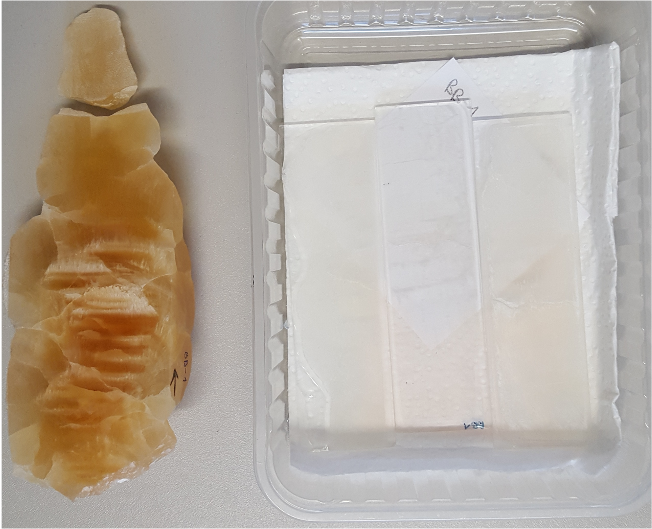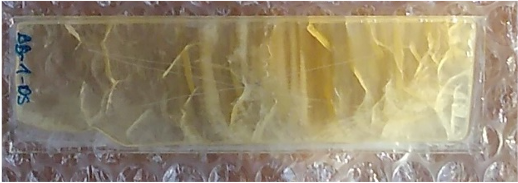Lage
Nordgang, nahe „Krampfaderkeule“, zwischen MP 6/136 und MP 6/137
Probennahme
x. Januar 2009: Name? (THV)
Verbleib
NU Newcastle, GFZ Potsdam
DatierungDatierung Um einem Stalagmiten oder gar einer einzelnen Wachstumslage im Stalagmiten ein Alter zuordnen zu können, muß eine Datierung durchgeführt werden. Dies erfolgt in der Regel radiometrisch, d. h. über die Messung von Zerfallsprodukten (siehe auch U/Th-Datierung).
U/ThU/Th-Datierung Die U/Th-Datierung ist eine sehr präzise radiometrische Altersbestimmung auf Basis der Uran-Thorium-Zerfallsreihe. Das Uran zerfällt mit bekannten Halbwertszeiten (245.500 Jahre) zum Tochterelement Thorium. Stalagmiten bauen bei ihrem Wachstum (fast) nur das wasserlösliche Uran ein, während das schlecht bewegliche Thorium zum größten Teil im Boden und Epikarst über der Höhle verbleibt. Das kann man nutzen, um die Zeit zu berechnen, die seit der Ausfällung der untersuchten Karbonatprobe vergangen ist. Moderne massenspektrometrische Verfahren erlauben Altersbestimmungen mit der U/Th-Methode bis zu 700.000 Jahren vor Heute., 18 Alter, gemessen an der JGU Mainz
0.599 ± 0.011 ka BPka BP Mit "ka BP" sind "Tausend Jahre vor 1950" gemeint. Das "BP" steht für "before present", was in der Paläoklima-Wissenschaft als 1950 festgelegt wurde. "11.000 ka BP" bedeuted also 11 Tausend Jahre vor 1950, oder unter Verwendung unseres gewohnten Kalenders: 9050 v. Chr. (top)
5.539 ± 0.045 ka BP (bottom)
ProxiesProxy Umwelt- und Klimainformationen aus der Vergangenheit sind nicht direkt verfügbar, weil niemand da war, der diese messen und aufzeichnen konnte. Daher ist man darauf angewiesen, diese Informationen indirekt aus anderen Informationen abzuleiten, wie z. B. Baumringe, das Verhältnis von Sauerstoffisotopen, Spurenelementen, Mächtigkeit von Sedimentschichten usw. Diese Art von Daten nennt man Proxies, was aus dem englischen stammt und „Stellvertreter“ bedeutet.
δ18O
δ13C
δ86/87Sr
Elemente (Sr/Ca, S/Ca)
Dünnschliffe
Publikationen
Breitenbach, Sebastian F. M.; Marwan, Norbert
Die Bleßberghöhle – ein Glücksfall für die Klimaforschung Buchabschnitt
In: Thüringer Höhlenverein, e. V. (Hrsg.): Nächster Halt: Bleßberghöhle, Suhl, 2022.
@incollection{breitenbach_bbh2022,
title = {Die Bleßberghöhle – ein Glücksfall für die Klimaforschung},
author = {Sebastian F. M. Breitenbach and Norbert Marwan},
editor = {Thüringer Höhlenverein, e. V.},
year = {2022},
date = {2022-02-22},
urldate = {2022-02-22},
booktitle = {Nächster Halt: Bleßberghöhle},
address = {Suhl},
abstract = {Höhlen stellen generell für die Wissenschaft ein wertvolles Archiv dar, aus dem vielfältige und interessante Erkenntnisse gewonnen werden können. So gehören sie inzwischen auch zu den bedeutendsten Klimaarchiven auf dem Festland (See- und Meeressedimente stellen andere wichtige Archive dar). Solange die Höhlensedimente und Sinter ungestört bleiben, können hydrologische und klimatische Bedingungen detailliert aufgezeichnet werden. Die Bleßberghöhle ist in diesem Zusammenhang ein ausgesprochener Glücksfall, da sie über viele Jahrtausende komplett verschlossen war und so vor äußeren Störungen bewahrt wurde. Sie ist in vielen Abschnitten mit verschiedensten Sinterformen geschmückt. Für die Rekonstruktion regionaler Klimaänderungen sind vor allem die Stalagmiten geeignet. Die wissenschaftliche Bearbeitung des aus der Bleßberghöhle gesammelten Materials ist ein langwieriger Prozess und noch lange nicht abgeschlossen. Zum gegenwärtigen Zeitpunkt können aber bereits erste interessante Aussagen gemacht werden, auf die wir hier nach einem kurzen allgemeinen Einblick in verschiedene Aspekte der Paläoklimaforschung eingehen wollen.},
keywords = {},
pubstate = {published},
tppubtype = {incollection}
}
Marwan, Norbert; Kraemer, Kai Hauke; Wiesner, Karolin; Breitenbach, Sebastian F. M.; Leonhardt, Jens
Recurrence based entropies Vortrag
07.05.2019, (Fourth International Conference on Recent Advances in Nonlinear Mechanics, Łódz (Poland)).
@misc{marwan2019lodz,
title = {Recurrence based entropies},
author = {Norbert Marwan and Kai Hauke Kraemer and Karolin Wiesner and Sebastian F. M. Breitenbach and Jens Leonhardt},
editor = {Fourth International Conference on Recent Advances in Nonlinear Mechanics, Łódz (Poland)},
year = {2019},
date = {2019-05-07},
abstract = {Many dynamical processes are considered to be of complex nature. To get a quantitative idea of the complexity, often the Shannon entropy of the value distribution of a measurement is used. Alternative entropy measures have been suggested using the recurrence plot (RP) approach. A RP is a matrix that represents the recurrences of states in the d-dimensional phase space. The RP can consist of small-scale structures, such as single points, diagonal and vertical lines, which characterize important dynamical properties of the system. Various entropy measures have been defined using different features of the RP or can be related to certain properties of the RP. Because of the different features that are used, some entropy measures represent different aspects of the analysed system and, thus, behave differently. This fact can lead to misunderstandings and difficulties in interpreting and understanding those measures. We discuss definitions, motivation and interpretation of some of those entropy measures, compare their differences and discuss some of the pitfalls when using them. },
note = {Fourth International Conference on Recent Advances in Nonlinear Mechanics, Łódz (Poland)},
keywords = {},
pubstate = {published},
tppubtype = {presentation}
}
Marwan, Norbert; Kraemer, Kai Hauke; Wiesner, Karolin; Breitenbach, Sebastian F. M.; Leonhardt, Jens
Recurrence based entropies Proceedings Article
In: Geophysical Research Abstracts, S. EGU2019-2817, 2019.
@inproceedings{marwan2019,
title = {Recurrence based entropies},
author = {Norbert Marwan and Kai Hauke Kraemer and Karolin Wiesner and Sebastian F. M. Breitenbach and Jens Leonhardt},
url = {https://bbh.pik-potsdam.de/wp-content/uploads/2021/04/EGU2019-2817.pdf},
year = {2019},
date = {2019-04-08},
booktitle = {Geophysical Research Abstracts},
volume = {21},
pages = {EGU2019-2817},
abstract = {Dynamical processes in Earth sciences are often considered to be of complex nature. The term complexity is often used for processes that are either unpredictable (e.g. nonlinear dynamics), consist of many different components, or exhibit regime transitions (e.g. tipping points). To measure complexity, the Shannon entropy is often used.
Here we present various entropy measures that have been defined on the base of the recurrence plot. Because of the different features that are used, these entropy measures represent different aspects of the analysed system and, thus, behave differently. In the past, this fact has lead to difficulties in interpreting and understanding those measures. We summarize the definitions, the motivation and interpretation of these entropy measures, compare their differences and discuss some of the pitfalls when using them.
Finally, we illustrate their potential in an application on palaeoclimate time series. Using entropy measures, changes and transitions in the climate dynamics in the past can be identified and interpreted.},
keywords = {},
pubstate = {published},
tppubtype = {inproceedings}
}
Here we present various entropy measures that have been defined on the base of the recurrence plot. Because of the different features that are used, these entropy measures represent different aspects of the analysed system and, thus, behave differently. In the past, this fact has lead to difficulties in interpreting and understanding those measures. We summarize the definitions, the motivation and interpretation of these entropy measures, compare their differences and discuss some of the pitfalls when using them.
Finally, we illustrate their potential in an application on palaeoclimate time series. Using entropy measures, changes and transitions in the climate dynamics in the past can be identified and interpreted.
Breitenbach, Sebastian F. M.; Plessen, Birgit; Waltgenbach, Sarah; Tjallingii, Rik; Leonhardt, Jens; Jochum, Klaus-Peter; Meyer, Hanno; Goswami, Bedartha; Marwan, Norbert; Scholz, Denis
In: Global and Planetary Change, Bd. 176, S. 144–161, 2019.
@article{breitenbach2019,
title = {Holocene interaction of maritime and continental climate in Central Europe: New speleothem evidence from Central Germany},
author = {Sebastian F. M. Breitenbach and Birgit Plessen and Sarah Waltgenbach and Rik Tjallingii and Jens Leonhardt and Klaus-Peter Jochum and Hanno Meyer and Bedartha Goswami and Norbert Marwan and Denis Scholz},
doi = {10.1016/j.gloplacha.2019.03.007},
year = {2019},
date = {2019-00-00},
journal = {Global and Planetary Change},
volume = {176},
pages = {144–161},
abstract = {Central European climate is strongly influenced by North Atlantic (Westerlies) and Siberian High circulation patterns, which govern precipitation and temperature dynamics and induce heterogeneous climatic conditions, with distinct boundaries between climate zones. These climate boundaries are not stationary and shift geographically, depending on long-term atmospheric conditions. So far, little is known about past shifts of these climate boundaries and the local to regional environmental response prior to the instrumental era.
High resolution multi-proxy data (stable oxygen and carbon isotope ratios, S/Ca and Sr/Ca) from two Holocene stalagmites from Bleßberg Cave (Thuringia) are used here to differentiate local and pan-regional environmental and climatic conditions Central Germany through the Holocene. Carbon isotope and S/Ca and Sr/Ca ratios inform us on local Holocene environmental changes in and around the cave, while δ18O (when combined with independent records) serves as proxy for (pan-)regional atmospheric conditions.
The stable carbon isotope record suggests repeated changes in vegetation density (open vs. dense forest), and increasing forest cover in the late Holocene. Concurrently, decreasing S/Ca values indicate more effective sulfur retention in better developed soils, with a stabilization in the mid-Holocene. This goes in hand with changes in effective summer infiltration, reflected in the Sr/Ca profile. Highest Sr/Ca values between 4 ka and 1 ka BP indicate intensified prior calcite precipitation resulting from reduced effective moisture supply.
The region of Bleßberg Cave is sensitive to shifts of the boundary between maritime (Cfb) and continental (Dfb) climate and ideally suited to reconstruct past meridional shifts of this divide. We combined the Bleßberg Cave δ18O time series with δ18O data from Bunker Cave (western Germany) and a North Atlantic Oscillation (NAO) record from lake SS1220 (SW Greenland) to reconstruct the mean position of the Cfb-Dfb climate boundary. We further estimate the dynamic interplay of the North Atlantic Oscillation and the Siberian High and their influence on Central European climate. Repeated shifts of the Cfb-Dfb boundary over the last 4000 years might explain previously observed discrepancies between proxy records from Europe. Detailed correlation analyses reveal multi-centennial scale alternations of maritime and continental climate and, concurrently, waning and waxing influences of Siberian High and NAO on Central Europe.},
keywords = {},
pubstate = {published},
tppubtype = {article}
}
High resolution multi-proxyProxy Umwelt- und Klimainformationen aus der Vergangenheit sind nicht direkt verfügbar, weil niemand da war, der diese messen und aufzeichnen konnte. Daher ist man darauf angewiesen, diese Informationen indirekt aus anderen Informationen abzuleiten, wie z. B. Baumringe, das Verhältnis von Sauerstoffisotopen, Spurenelementen, Mächtigkeit von Sedimentschichten usw. Diese Art von Daten nennt man Proxies, was aus dem englischen stammt und „Stellvertreter“ bedeutet. data (stable oxygen and carbon isotopeIsotop Chemische Elemente können aus verschieden aufgebauten Atomen gebildet sein. Die Anzahl Protonen im Atomkern ist zwar dabei gleich, aber die Anzahl der Neutronen kann variieren. Man spricht dann von Isotopen, deren Massen kleine, aber messbare Unterschiede aufweisen. Der Atomkern des Sauerstoffs besteht z. B. aus 8 Protonen und in der Regel aus 8 Neutronen. Es gibt aber auch Sauerstoff, dessen Kerne aus 8 Protonen und 9 oder 10 Neutronen bestehen (neben selteneren, instabilen Sauerstoffisotopen). Um das zu kennzeichnen, gibt man zusätzlich zum chemischen Symbol noch die Massenzahl (Summe aus Protonen und Neutronen) an, also 16O, 17O oder 18O. Die unterschiedlichen Isotope verhalten sich zwar chemisch identisch, physikalisch aber - aufgrund ihres unterschiedlichen Gewichtes - leicht unterschiedlich. Damit stellen sie äusserst wertvolle Marker dar, die uns wichtige Hinweise zur Änderung des Klimas, der Umgebungsvegetation, Bodenaktivität und vielem mehr geben. ratios, S/Ca and Sr/Ca) from two Holocene stalagmites from Bleßberg Cave (Thuringia) are used here to differentiate local and pan-regional environmental and climatic conditions Central Germany through the Holocene. Carbon isotope and S/Ca and Sr/Ca ratios inform us on local Holocene environmental changes in and around the cave, while δ18O (when combined with independent records) serves as proxyProxy Umwelt- und Klimainformationen aus der Vergangenheit sind nicht direkt verfügbar, weil niemand da war, der diese messen und aufzeichnen konnte. Daher ist man darauf angewiesen, diese Informationen indirekt aus anderen Informationen abzuleiten, wie z. B. Baumringe, das Verhältnis von Sauerstoffisotopen, Spurenelementen, Mächtigkeit von Sedimentschichten usw. Diese Art von Daten nennt man Proxies, was aus dem englischen stammt und „Stellvertreter“ bedeutet. for (pan-)regional atmospheric conditions.
The stable carbon isotope record suggests repeated changes in vegetation density (open vs. dense forest), and increasing forest cover in the late Holocene. Concurrently, decreasing S/Ca values indicate more effective sulfur retention in better developed soils, with a stabilization in the mid-Holocene. This goes in hand with changes in effective summer infiltration, reflected in the Sr/Ca profile. Highest Sr/Ca values between 4 kaka BP Mit "ka BP" sind "Tausend Jahre vor 1950" gemeint. Das "BP" steht für "before present", was in der Paläoklima-Wissenschaft als 1950 festgelegt wurde. "11.000 ka BP" bedeuted also 11 Tausend Jahre vor 1950, oder unter Verwendung unseres gewohnten Kalenders: 9050 v. Chr. and 1 ka BP indicate intensified prior calcite precipitation resulting from reduced effective moisture supply.
The region of Bleßberg Cave is sensitive to shifts of the boundary between maritime (Cfb) and continental (Dfb) climate and ideally suited to reconstruct past meridional shifts of this divide. We combined the Bleßberg Cave δ18O time series with δ18O data from Bunker Cave (western Germany) and a North Atlantic Oscillation (NAO) record from lake SS1220 (SW Greenland) to reconstruct the mean position of the Cfb-Dfb climate boundary. We further estimate the dynamic interplay of the North Atlantic Oscillation and the Siberian High and their influence on Central European climate. Repeated shifts of the Cfb-Dfb boundary over the last 4000 years might explain previously observed discrepancies between proxy records from Europe. Detailed correlation analyses reveal multi-centennial scale alternations of maritime and continental climate and, concurrently, waning and waxing influences of Siberian High and NAO on Central Europe.
Breitenbach, Sebastian F. M.; Plessen, Birgit; Waltgenbach, Sarah; Tjallingii, Rik; Leonhardt, Jens; Jochum, Klaus-Peter; Meyer, Hanno; Marwan, Norbert; Scholz, Denis
Tracing past shifts of the boundary between maritime and continental climate over Central Europe Proceedings Article
In: Geophysical Research Abstracts, S. EGU2018-9046, 2018.
@inproceedings{breitenbach2018,
title = {Tracing past shifts of the boundary between maritime and continental climate over Central Europe},
author = {Sebastian F. M. Breitenbach and Birgit Plessen and Sarah Waltgenbach and Rik Tjallingii and Jens Leonhardt and Klaus-Peter Jochum and Hanno Meyer and Norbert Marwan and Denis Scholz},
url = {https://bbh.pik-potsdam.de/wp-content/uploads/2021/04/EGU2018-9046.pdf},
year = {2018},
date = {2018-04-01},
booktitle = {Geophysical Research Abstracts},
volume = {20},
pages = {EGU2018-9046},
abstract = { European climate is characterized by heterogeneous climate conditions, with distinct boundaries between zones that can be classified according to the Köppen classification (Peel et al. 2007), and detected using climate network techniques (Rheinwalt et al. 2016). These boundaries are not stationary, but shift geographically, depending on large scale atmospheric conditions. Central European climate is strongly influenced by intricately linked North Atlantic Oscillation and Siberian High (SH), which govern precipitation and temperature over Europe. Shifts of these climatic boundaries in response to global warming and circulation changes might lead to more frequent extreme weather patterns like heat waves, with significant repercussions for society (Cohen et al. 2014). Speleothem-based palaeoclimate reconstructions enable us to understand underlying forcing mechanisms and speed of climatic reorganizations. Here we present a first reconstruction of multi-centennial shifts of the boundary between western European maritime Cfb climate and continental Dfb climate through the last ca. 5,000 years using speleothems from Bleßberg Cave, Thuringia, Central Europe. Thanks to its location near the Cfb-Dfb climatic boundary, Bleßberg Cave is ideally suited to reconstruct past W-E shifts of this divide longitudinally crossing Central Europe. We compare a decadally resolved stalagmite δ18O record with data from Bunker Cave (Mischel et al. 2017), western Germany, and an NAO reconstruction from Greenland (Olsen et al. 2012). Over the last 5,000 years, the boundary between Cfb and Dfb climate shifted repeatedly. When the Cfb-Dfb border was east (west) of Bleßberg (Bunker) Cave maritime (continental) climate prevailed at both sites. Discrepancies between investigated proxy records are found when the boundary is located between the two caves. Comparison with the Greenland NAO record shows that a westerly shifted boundary is often associated with a strong SH and a negative NAO. An easterly shift, in contrast, is found to be linked with weak a SH and a positive NAO.},
keywords = {},
pubstate = {published},
tppubtype = {inproceedings}
}
Breitenbach, Sebastian F. M.; Plessen, Birgit; Wenz, Sarah; Leonhardt, Jens; Tjallingii, Rik; Scholz, Denis; Jochum, Klaus-Peter; Marwan, Norbert
A multi-proxy reconstruction of Holocene climate change from Blessberg Cave, Germany Proceedings Article
In: Geophysical Research Abstracts, S. EGU2016-14213, 2016.
@inproceedings{breitenbach2016,
title = {A multi-proxy reconstruction of Holocene climate change from Blessberg Cave, Germany},
author = {Sebastian F. M. Breitenbach and Birgit Plessen and Sarah Wenz and Jens Leonhardt and Rik Tjallingii and Denis Scholz and Klaus-Peter Jochum and Norbert Marwan},
url = {https://bbh.pik-potsdam.de/wp-content/uploads/2021/05/Breitenbach_poster_EGU_2016.pdf},
year = {2016},
date = {2016-04-01},
booktitle = {Geophysical Research Abstracts},
volume = {18},
pages = {EGU2016-14213},
abstract = {Although Holocene climate dynamics were relatively stable compared to glacial conditions, climatic changes had significant impact on ecosystems and human society on various timescales (Mayewski et al. 2004, Donges et al. 2015, Tan et al. 2015). Precious few high-resolution records on Holocene temperature and precipitation conditions in Central Europe are available (e.g., von Grafenstein et al. 1999, Fohlmeister et al. 2012).
Here we present a speleothem-based reconstruction of past climate dynamics from Blessberg Cave, Thuringia, central Germany. Three calcitic stalagmites were recovered when the cave was discovered during tunneling operations in 2008. Samples BB-1, -2 and -3 were precisely dated by the 230Th/U-method, with errors between 10 and 160 years (2σ). The combined record covers large parts of the Holocene (10 – 0.4 ka BP). δ13C and δ18O were analysed at 100 μm resolution. To gain additional insights in infiltration conditions, Sr/Ca and S/Ca were measured on BB-1 and BB-3 using an Röntgenanalytik Eagle XXL μXRF scanner.
Differences to other central European records (e.g., von Grafenstein et al. 1999, Fohlmeister et al. 2012) suggest complex interaction between multiple factors influencing speleothem δ18O in Blessberg Cave. Furthermore, no clear influence of the North Atlantic Oscillation on our proxies is found. However, a link across the N Atlantic realm is indicated by a centennial-scale correlation between Blessberg δ18O values and minerogenic input into lake SS1220 in Greenland over the last 5 ka (Olsen et al. 2012). In addition, recurrence analysis indicates an imprint of Atlantic Bond events on Blessberg δ18O values (Marwan et al. 2014), corroborating the suggested link with high northern latitudes. Larger runoff into the Greenland lake seems to be associated with lower δ18O, higher δ13C and S/Ca ratios, as well as lower Sr/Ca ratios in Blessberg Cave speleothems. This might be linked to lower local temperature and/or changes in precipitation seasonality. Opposing millennial scale trends with lowering S/Ca ratios and δ13C values but increasing Sr/Ca ratios calls for more than one controlling factor. Most likely, δ13C decreased through the Holocene due to afforestation, which in turn might have increased sulphate retention in the thickening soil cover (Frisia et al. 2005) and limited sulphur flux into the cave. Alternatively, marine sulfur flux could have diminished with winter wind intensities. However, additional data is required to clarify this hypothesis. A positive Sr/Ca trend through the Holocene might result from increasing prior calcite precipitation induced by a negative moisture balance in summer.},
keywords = {},
pubstate = {published},
tppubtype = {inproceedings}
}
Here we present a speleothem-based reconstruction of past climate dynamics from Blessberg Cave, Thuringia, central Germany. Three calcitic stalagmites were recovered when the cave was discovered during tunneling operations in 2008. Samples BB-1, -2 and -3 were precisely dated by the 230Th/UU/Th-Datierung Die U/Th-Datierung ist eine sehr präzise radiometrische Altersbestimmung auf Basis der Uran-Thorium-Zerfallsreihe. Das Uran zerfällt mit bekannten Halbwertszeiten (245.500 Jahre) zum Tochterelement Thorium. Stalagmiten bauen bei ihrem Wachstum (fast) nur das wasserlösliche Uran ein, während das schlecht bewegliche Thorium zum größten Teil im Boden und Epikarst über der Höhle verbleibt. Das kann man nutzen, um die Zeit zu berechnen, die seit der Ausfällung der untersuchten Karbonatprobe vergangen ist. Moderne massenspektrometrische Verfahren erlauben Altersbestimmungen mit der U/Th-Methode bis zu 700.000 Jahren vor Heute.-method, with errors between 10 and 160 years (2σ). The combined record covers large parts of the Holocene (10 – 0.4 ka BP). δ13C and δ18O were analysed at 100 μm resolution. To gain additional insights in infiltration conditions, Sr/Ca and S/Ca were measured on BB-1 and BB-3 using an Röntgenanalytik Eagle XXL μXRF scanner.
Differences to other central European records (e.g., von Grafenstein et al. 1999, Fohlmeister et al. 2012) suggest complex interaction between multiple factors influencing speleothem δ18O in Blessberg Cave. Furthermore, no clear influence of the North Atlantic Oscillation on our proxies is found. However, a link across the N Atlantic realm is indicated by a centennial-scale correlation between Blessberg δ18O values and minerogenic input into lake SS1220 in Greenland over the last 5 ka (Olsen et al. 2012). In addition, recurrence analysis indicates an imprint of Atlantic Bond events on Blessberg δ18O values (Marwan et al. 2014), corroborating the suggested link with high northern latitudes. Larger runoff into the Greenland lake seems to be associated with lower δ18O, higher δ13C and S/Ca ratios, as well as lower Sr/Ca ratios in Blessberg Cave speleothems. This might be linked to lower local temperature and/or changes in precipitation seasonality. Opposing millennial scale trends with lowering S/Ca ratios and δ13C values but increasing Sr/Ca ratios calls for more than one controlling factor. Most likely, δ13C decreased through the Holocene due to afforestation, which in turn might have increased sulphate retention in the thickening soil cover (Frisia et al. 2005) and limited sulphur flux into the cave. Alternatively, marine sulfur flux could have diminished with winter wind intensities. However, additional data is required to clarify this hypothesis. A positive Sr/Ca trend through the Holocene might result from increasing prior calcite precipitation induced by a negative moisture balance in summer.
